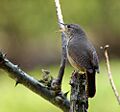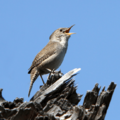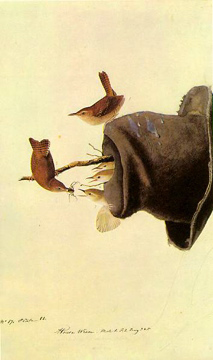House wren facts for kids
Quick facts for kids House wren |
|
|---|---|
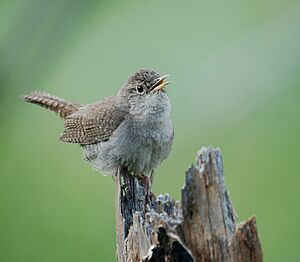 |
|
| Northern house wren Bandelier National Monument (New Mexico, US) |
|
| Conservation status | |
| Scientific classification | |
| Genus: |
Troglodytes
|
| Species: |
aedon
|
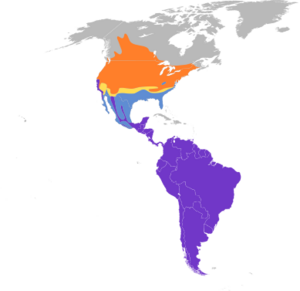 |
|
| Breeding
Migration Nonbreeding Year-round |
|
The house wren (Troglodytes aedon) is a very small bird from the wren family. You can find them from Canada all the way down to the very south of South America. This makes them the most widespread native bird in the Americas! They live in most towns and cities in their range and are the most common type of wren. Their name troglodytes means "hole dweller." This is because they often disappear into small cracks and holes when they are hunting for insects or looking for a safe place to hide.
Contents
House Wren Family Tree
Scientists first officially described the house wren in 1809. The name aedon comes from an old Greek word meaning "nightingale."
There are 32 different types of house wrens, called subspecies. Think of them like different versions of the same bird, often living in different places. These subspecies are sometimes grouped into three main types, plus a few special ones that only live on certain islands:
- Northern house wren: Found from Canada to the southern United States.
- Southern house wren: Lives in southern Mexico, Central, and South America.
- Brown-throated wren: Found in the southern United States and central parts of Mexico.
- Cozumel wren: Lives only on Cozumel Island near the Yucatán Peninsula in Mexico.
Some birds that were once thought to be house wrens are now considered their own separate species. These include:
- Cobb's wren from the Falkland Islands.
- Socorro wren from Socorro Island.
- Clarión wren from Clarion Island.
What Does a House Wren Look Like?
Adult house wrens are small, usually about 11 to 13 centimeters (4 to 5 inches) long. Their wings can spread about 15 centimeters (6 inches) wide, and they weigh around 10 to 12 grams (less than half an ounce).
Their feathers can be different colors depending on where they live. Some are dull grayish-brown, while others are a rich reddish-brown. Their undersides can be brown, light yellow, pale gray, or even pure white. All house wrens have dark stripes on their wings and tail. Some also have stripes on their sides. They have a faint ring around their eyes and a long, thin beak. Their legs are usually pinkish or gray. They often hold their short tail pointing upwards.
You'll often hear their cheerful, bubbly song during the spring and summer when they are nesting. Their song can sound quite different depending on where the bird lives, even if it's just on a nearby island!
-
Southern house wren in São Paulo, Brazil
-
Northern house wren singing in San Luis Obispo, California, USA
-
A young house wren with missing tail feathers in East Hartford, Connecticut, USA
Where Do House Wrens Live and What Do They Eat?
In North America, house wrens are often found in forests near rivers, where they like to use old woodpecker holes for their nests. In South and Central America, you can find them almost anywhere, often living close to people.
North American house wrens fly south to the southern United States and Mexico for the winter. They usually come back to their breeding areas in late April or May and leave again around September or early October.
These birds are very active as they search for food in plants. They mostly eat insects like butterfly larvae, beetles, and bugs. They also enjoy spiders and snails.
House Wren Life Cycle
House wrens build their nests in various hollow spaces, like tree cavities or even birdhouses. It takes them about a week to build a nest. They use small, dry sticks and line the nest with soft materials like feathers, hair, wool, spider webs, bark, and moss. The male brings the sticks, and the female checks them. If she doesn't like a stick, she'll throw it out! After the male is done, the female adds the soft lining.
Even though they are tiny, house wrens can be quite feisty! They are known to sometimes destroy the eggs of other birds nesting nearby by poking holes in them. They might also fill other birds' nests in their area with sticks to make them unusable.
A female house wren usually lays between two and eight cream-white eggs with red spots. Each egg weighs about 1.4 grams (0.05 ounces). Only the female sits on the eggs to keep them warm, which takes about 12 to 19 days. While she's on the nest, the male brings her food.
When the chicks hatch, they are tiny and helpless. They stay in the nest for another 15 to 19 days. Both parents feed the young birds, bringing them lots of food because they grow so quickly!
Some animals that hunt house wrens at the nest include cats, rats, opossums, woodpeckers, foxes, raccoons, squirrels, snakes, and owls. Adult wrens can usually escape these predators, but small hawks and owls sometimes catch them.
In some areas, house wrens can raise a second family of chicks in one season.
Scientists have studied house wrens in different places. In cities, parents might make more trips to feed their babies than in the countryside. However, babies in the countryside sometimes grow faster. This might mean that the food in city backyards isn't as good or as plentiful as the food in wilder areas.
Protecting House Wrens
The house wren is still very common and widespread across most of the Americas. However, some of the subspecies that live only on islands are rare and in danger, or might even be extinct. Several things have caused these birds to disappear:
- Habitat destruction: Their homes are being destroyed.
- Predators: Animals like mongooses, which were brought to the islands by people, hunt them.
- Hurricane]]s: Strong storms can wipe out their populations.
Some examples of endangered or possibly extinct island wrens include:
- Martinique house wren (Troglodytes aedon martinicensis) from Martinique, likely extinct since around 1890.
- Guadeloupe house wren (Troglodytes aedon guadeloupensis) from Guadeloupe, possibly extinct by the late 20th century.
- Saint Lucia house wren (Troglodytes aedon mesoleucus) from Saint Lucia, thought to be extinct by the 1970s, but thankfully rediscovered, though still very rare.
The Saint Vincent house wren (Troglodytes aedon musicus) from Saint Vincent was also close to disappearing in the mid-1900s, but its numbers have grown, and it's not uncommon today.
House Wrens in Stories and Sports
The famous artist John James Audubon included the house wren in his book Birds of America.
A wooden house wren named Troglodytes Aedon (or Trog for short) was one of King Friday the XIII's pets in Mister Rogers' Neighborhood. Trog even had his own song!
The famous Brazilian soccer player Garrincha got his nickname from one of the names for the house wren in Rio de Janeiro.



